El Nido, Palawan
El Nido, officially the Municipality of El Nido (Cuyonon: Banwa i'ang El Nido, Tagalog: Bayan ng El Nido), is a 1st class municipality in the province of Palawan, Philippines. According to the 2015 census, it has a population of 41,606 people. [4]
El Nido | |
|---|---|
| Municipality of El Nido | |
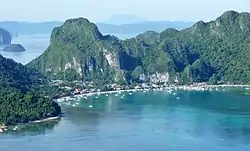 View of El Nido | |
 Seal | |
| Nickname(s): Heaven on Earth[1] | |
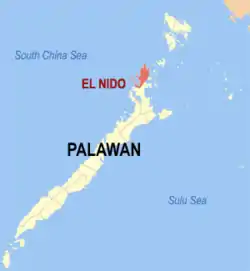 Map of Palawan with El Nido highlighted | |
OpenStreetMap 
| |
.svg.png.webp) El Nido Location within the Philippines | |
| Coordinates: 11°11′44″N 119°24′27″E | |
| Country | |
| Region | Mimaropa (Region IV-B) |
| Province | Palawan |
| District | 1st district |
| Founded | 1916 |
| Renamed | June 17, 1954 |
| Barangays | 18 (see Barangays) |
| Government | |
| • Type | Sangguniang Bayan |
| • Mayor | Edna G. Lim |
| • Vice Mayor | Luningning L. Batoy |
| • Representative | Franz Josef George E. Alvarez |
| • Electorate | 27,679 voters (2019) |
| Area | |
| • Total | 923.26 km2 (356.47 sq mi) |
| Elevation | 35 m (115 ft) |
| Highest elevation | 596 m (1,955 ft) |
| Lowest elevation | 0 m (0 ft) |
| Population | |
| • Total | 41,606 |
| • Density | 45/km2 (120/sq mi) |
| • Households | 9,465 |
| Economy | |
| • Income class | 1st municipal income class |
| • Poverty incidence | 22.11% (2015)[5] |
| • Revenue | ₱290,343,349.24 (2016) |
| Service provider | |
| • Electricity | Palawan Electric Cooperative |
| Time zone | UTC+8 (PST) |
| ZIP code | 5313 |
| PSGC | |
| IDD : area code | +63 (0)48 |
| Climate type | tropical climate |
| Native languages | Palawano Tagalog |
| Website | www |
It is about 420 kilometres (260 mi) south-west of Manila,[6] and about 238 kilometres (148 mi) north-east of Puerto Princesa, Palawan's capital.[7] A managed resource protected area,[7] it is known for its white-sand beaches, coral reefs, limestone cliffs and as the gateway to the Bacuit archipelago.
El Nido is currently ranked #4 in Condé Nast Traveler's list of "20 Most Beautiful Beaches in the World." [8] CNNgo has called it the Best Beach and Island destination in the Philippines[9][10] for its "extraordinary natural splendor and ecosystem."[11]
Geography
Situated in Bacuit Bay, El Nido, covering a land area of 465.1 square kilometres (179.6 sq mi)[7][12] in the northernmost tip of mainland Palawan, is bordered by the Linapacan Strait in the north, the Sulu Sea in the east, and the South China Sea in the west. It is composed of 45 islands and islets,[6] each has its own unique geological formations. The highest peak is at Cadlao Island, towering up to 640 metres (2,100 ft)[13] above sea level.
Together with Sulu Archipelago, Sabah, and South China Sea, El Nido, being part of Palawan, is located in the tectonically active and seismically active Sunda Plate,[14] a plate that is entirely separate from the Philippine Mobile Belt to which the rest of the Philippines belongs. The Permian to Paleogene rocks and limestone cliffs of El Nido are similar to those that can be found in Ha Long Bay in Vietnam, Guilin in China, as well as Krabi in Thailand, all of which are part of the Sunda Plate.[14][15]
Barangays
El Nido is politically subdivided into eighteen barangays. Four of which are situated in the Población (town proper), and are also known by their respective zones.
- Bagong Bayan
- Buena Suerte (Zone II)
- Barotuan
- Bebeladan
- Corong-corong (Zone IV)
- Mabini (formerly Oton)
- Manlag
- Masagana (Zone III)
- New Ibajay
- Pasadeña
- Maligaya (Zone I)
- San Fernando
- Sibaltan
- Teneguiban
- Villa Libertad
- Villa Paz
- Bucana
- Aberawan
Población (Town proper)

The Poblacion, consisting of barangays Buena Suerte, Corong-corong, Maligaya and Masagana, sits in a sheltered bay with a pier at one end along a crescent beach, and is flanked by the area's famous limestone cliffs on the eastern section and hills on the western side. It is a small town center with tree-lined streets, and the lifestyle is laidback.
The Municipal Building, which houses the offices of the head of the municipality, the local legislature and several local government agencies, is located at the middle of the town square between Calle Real and Abdulla Street. It is interconnected with other buildings that house other government facilities such as the Rural Health Unit, Municipal Circuit Trial Court, El Nido Post Office, just to name a few.
Climate
| Climate data for El Nido, Palawan | |||||||||||||
|---|---|---|---|---|---|---|---|---|---|---|---|---|---|
| Month | Jan | Feb | Mar | Apr | May | Jun | Jul | Aug | Sep | Oct | Nov | Dec | Year |
| Average high °C (°F) | 27 (81) |
31 (88) |
31 (88) |
32 (90) |
32 (90) |
31 (88) |
25 (77) |
31 (88) |
30 (86) |
31 (88) |
31 (88) |
28 (82) |
30 (86) |
| Average low °C (°F) | 22 (72) |
23 (73) |
23 (73) |
24 (75) |
25 (77) |
25 (77) |
20 (68) |
24 (75) |
23 (73) |
24 (75) |
24 (75) |
23 (73) |
23 (74) |
| Average rainfall mm (inches) | 6 (0.2) |
0 (0) |
12 (0.5) |
39 (1.5) |
117 (4.6) |
351 (13.8) |
435 (17.1) |
375 (14.8) |
159 (6.3) |
159 (6.3) |
45 (1.8) |
12 (0.5) |
1,710 (67.4) |
| Average rainy days | 2 | 1 | 3 | 4 | 17 | 25 | 26 | 24 | 20 | 19 | 9 | 4 | 154 |
| Source: World Weather Online (modelled/calculated data, not measured locally)[16] | |||||||||||||
The climate in El Nido is distinguished by two seasons: generally dry, from December to May, and wet, from June to November. April and May are typically the driest months, while the heaviest rainfall occurs around August. The Northeast wind blows from December to March, occasionally interchanging with the North wind during December to February. The Southwest wind is felt from June to October while the East wind, the mildest of all winds, blows during the months of April and May.[17]
The average surface temperature ranges from a low of 22 °C (72 °F) to a high of 33 °C (91 °F). The coolest temperatures are usually experienced during the month of January, while the hottest temperatures are felt in April and May.[17]
Sea conditions

The current in El Nido differ from very slight to moderate depending on tidal conditions. Divers and snorkellers can swim back to the boat without difficulty since currents are usually very manageable.[17]
The average water temperature ranges from 24 to 26 °C (75 to 79 °F) during the months of December to March and 26 to 29 °C (79 to 84 °F) during the months of April to November.[17]
Water visibility ranges from 3 to 10 metres (9.8 to 32.8 ft) from December to February, 10 to 30 metres (33 to 98 ft) from March to May, and 10 to 15 metres (33 to 49 ft) from June to November. The best time for diving at El Nido is during the months of March to May, as surface conditions are good.[17]
History
El Nido has been inhabited by humans as early 2680 BC, or even up to 22,000 years ago.[18] This was confirmed by the fossils and burial sites, dating back to the Late Neolithic Age, that can be found in many caves and excavation sites surrounding the municipality, particularly in Dewil Valley's Ille Cave in New Ibajay. Chinese traders had been regularly visiting the area of Palawan for its edible birds' nests during the Song Dynasty (960-1279). The island was mentioned in Chinese records of 1225. Chau Ju-Kua, a trade commissioner of the port of Chuan wrote about the island, Pa-Lao-Yu or Land of Beautiful Harbors in his book Chu Fan Chi.[6]
The town traces its roots from a small Tagbanwa village called Talindak. Some time in the 16th century, waves of migrants from Cuyo Islands came here to settle. In the 1800s, the Spaniards arrived, and they moved to the part where the present-day Población and Mabini are located.[6] The first Spanish families were the Canovas, Vázquez, Ríos and Rey. In 1890, the Spaniards renamed it as Bacuit. At the time, the center of the town was Cabigsing, then known as Inventario. Chinese families moved into the area about the same period, first settling in Langeblangeban. The first Chinese settlers were named Lim, Chin, Liao, Edsan, Ambao, Que-Ke, Lim Piao, Yu His, Pe Phan and Pe Khen.[6]
During the Spanish colonization of the Philippines, the town was under the jurisdiction of the Municipality of Taytay, which was the capital of the former Province of Calamianes from 1818, and the Province of Castilla, the area of what is now known as northern Palawan, from 1858. It remained part of Taytay until 1916 when it formally became an independent municipality.[6] The new municipality was then known as Bacuit.
On June 17, 1954, Republic Act No. 1140[19] was approved changing the name of the town from Bacuit to its present name El Nido after the edible nests of swiftlets (collocalia fuciphaga), found in the crevices of its limestone cliffs. These nests, nido in Spanish, the main ingredient for the gourmet nido soup, are being sold at approximately US$ 3,000 per kilogram.[7]
In 1957, the following barrios were created:
- Villa Paz comprising the sitios of New Igabas, Candolay, Malapaho, Mabeñgeten, Dewel, Nalbekan, and Lapia;
- Bebeladan comprising the sitios of Mainlong, Bolabod, Balete, Culiong, Codongnon, Vigan, Pagawanen, Langeblangeban, Talulap, Bocboc, Miadiao, Avirawan, Pita, Deboluan, Balay-Bacaco, Kiminawit, Pamontonan, Simpian, Binabanan, Tegas, and Pinacpanacan;
- Bagong-Bayan comprising the sitios of Manogtog, Cadleman, Pinagtual, Omao, Nami, Tebey, Bato, Tuñgay, Cataaban, and Lomocob;
- Pasadeña comprising the sitios of Lamoro, Cagbatang, Bulalacao, Pinañganteñgan, Quinawañgan, Nagbaclao, Colantod, Loblob, and Badiang;
- Sibaltan comprising the sitios of Turatod, Buluang, Santa Monica, Senodioc, Laolao, Caboñgan, Tapic, Panian, Guitan, Loro, and Nagcalasag;
- Barotuan comprising the sitios of Taberna, Locaroc, Nagpan, Yocoton, Calitang, Wawa, Makinit, Canoling, Mabañgaon, and Mapeldeten;
- San Fernando comprising the sitios of Panian, Madorianen, Dipnay, Maubog, Guenleng, Palabuayan, Parañgaycayan, San Pablo, and Olac-olacan; and,
- Villa Libertad comprising the sitios of Calelenday, Taolili, Boloc, Inigtan, Mepague, Matolatolaon, Dao, Batbat, Madacotdacot, Nasigdan, Semenled, Bancalen, and Cagbanaba.[20] In the same year, the barrio of Oton was renamed to Mabini.[21]
In April 2019, a bill dividing Palawan into three provinces was passed into law after the bill was signed by President Rodrigo Duterte.[22][23] The three new provinces are Palawan del Norte, Palawan Oriental, and Palawan del Sur.[22][23] A plebiscite will be held in May 2020 to decide on whether Palawan will be divided into three provinces or not. Some civil society groups opposed the proposed division, claiming that there was no extensive public consultation,[24] which was later proven as consultations and a study were only made in a single town, El Nido.[25] Additionally, reports have confirmed that China's Shanghai Electric Corporation has been tapped by the government to overtake Palawan's electric industry once the province has been divided in 2020.[25] The proposed electric base of the Chinese corporation will be at El Nido town, near the West Philippine Sea,[25] which China has claimed as its 'integral territory'.[26]
Demographics
|
| |||||||||||||||||||||||||||||||||||||||||||||
| Source: Philippine Statistics Authority [4] [27] [28][29] | ||||||||||||||||||||||||||||||||||||||||||||||
In the 2015 census, the population of El Nido was 41,606 people, [4] with a density of 45 inhabitants per square kilometre or 120 inhabitants per square mile.
The first town census of 1918 showed El Nido having a population of 1,789. In the period between 1980 and 1990, the population grew up to 18,832.[6][30] Based in the 2000 census, the annual growth rate is 3.58% .[31] This is higher than the average annual population growth rate for the whole country for the periods 1990 to 2000 and 2000 to 2007, which was only 2.34% and 2.04%.[32]
According to the 2007 census, El Nido has a population of 30,249 people in 6,311 households in its eighteen barangays. Eighty-five percent of the population are living in the rural barangays, while only fifteen percent of them are in the Población area.[33]
Ethnic Groups
The original settlers of El Nido were the Tagbanwas and Cuyunons. Throughout the centuries, there has been a constant migration of Tagalogs, Hiligaynon, Bicolanos, Ilocanos, Chinese and Spaniards. There are also a small number of Germans and Koreans. Intermarriage between ethnic and linguistic groups are not uncommon in El Nido.
Languages
The main language is Filipino, which is largely based on Tagalog. In addition, many people are very proficient in English, Hiligaynon, other Visayan languages, and Bicolano. A small but significant percentage of the population speaks or comprehends Cuyonon, the native Visayan language of the Cuyo Islands and most parts of Palawan.
Economy
The main industries of El Nido are fishing, agriculture and tourism, being a popular diving location. Edible nest-gathering[40] is also an economic activity, although it is seasonal. Coconut, palay, cashew, banana, and mango are its major products.[12]
Government


El Nido is governed by a Mayor and a Vice Mayor, who are elected to three-year terms. The Mayor is the executive head and leads the municipality's departments in executing the municipal ordinances and improving public services. The Vice Mayor heads the legislative council consisting of eight councilors, or more commonly known as Sangguniang Bayan members. The Municipal Council is in charge of creating the municipality's policies in the form of Ordinances and Resolutions.
Seal
The municipality seal shows a silhouette of the territory of El Nido inside an armor-shaped picture. The famous marble and limestone cliffs represents the nestling ground of the swiftlets. Behind it is the oil rig, representing the areas within its administrative boundaries that are found to be rich in oil and natural gas such as the Malampaya Sound, which is 50 kilometers[41] within its borders, and the Cadlao Oilfield in Bacuit Bay area.[42] At the bottom of the picture is the ricefield, with the carabao head superimposed at the center, and on the other side, the sea, with the fish and the squid in situated the middle, representing farming and fishing, the two main industries of its people.
Protected Area status
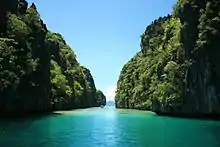
Establishment
In 1984, the then Ministry of Natural Resources issued the Administrative Order No. 518, establishing a 360 square kilometres (140 sq mi) maritime area in El Nido as a turtle sanctuary. In 1991, the rest of the Bacuit Bay, including its island and islets, was proclaimed by the Philippine government as a marine reserve. A year later, by virtue of Administrative Order No. 14 Series of 1992 of the Department of Environment and Natural Resources, this area was expanded even more. In 1998, its status was elevated to that of a protected area, and it included even the terrestrial ecosystem of El Nido and portions of Taytay.[43]
Extent and scope
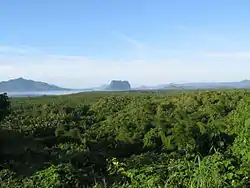
The so-called El Nido-Taytay Managed Resource Protected Area is the largest marine sanctuary in the entire Philippines.[44] The Protected Area status accords the areas of El Nido and portions of its neighboring town of Taytay[43] a place among the eight priority sites[13][45] in the country in need of conservation. The Protected Area covers a total of 903.21 square kilometers,[46] of which 40% are terrestrial and 60% marine.[47]
The provincial government has mobilized its citizenry to actively participate in various environmental conservation and protection programs, such as the "Bantay Gubat" for forest protection, and the "Bantay Dagat" for the marine life preservation.[41] Patrolling within the Protected Area especially in the marine zones is regularly conducted with the help of the World Wildlife Fund - Philippines that allocates funds to support the said activity. Other logistic support is by the concerned municipal governments. The Palawan Council for Sustainable Management (PCSD) provides legal assistance during the litigation of cases filed by the Protected Area Office (PAO).[46]
As a protected area, the Philippine government needs approximately US$ 180,000 annually to protect and manage its natural resources.[13][47] Tourists are encouraged to pay US$ 0.50 per day as conservation fee for the duration of their visit at the Municipal Tourism Office or the Office of the Protected Area Management Board (PAMB), which are housed in the Municipal Building in Calle Real.[47] This was embodied in the PAMB Resolution No. 08 series 2000 from the National Integrated Protected Area Program (NIPAP) of the Department of Environment and Natural Resources (DENR).[41]
El Nido, being one of the most diverse ecosystem in the country, is protected for its unique flora and fauna, and pristine geologic formations. These include:
- limestone cliffs, the home of the swiftlets
- 50 white sand beaches
- 5 types of forest (the lowland evergreen rainforests found in the mainland and islands such as Miniloc, Lagen and Pangulasian; semi-deciduous forests; forests over limestone; beach forests; and, the mangrove forests found mostly around major rivers and creeks in the mainland)
- 3 major marine habitats
- 16 endemic and 10 threatened species of birds (including the Palawan hornbill, the Palawan shama, the Palawan tit, Palawan scops owl, and the Palawan peacock pheasant)
- 6 species of marine mammals endemic to Palawan (including dolphins and its native dugong)
- the Palawan tree shrew, the Palawan stink badger, the Palawan spiny rat, the Palawan anteater, and the northern Palawan tree squirrel
- 4 species of endangered marine turtles (hawksbill, olive ridley, leatherback and green sea turtles)
- 100 species of corals,[48] 45 of which belongs to the genera of hard corals
- 813 species of fish
Infrastructure
Air
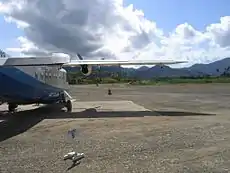
El Nido Airport also known as Lio Airport is the primary and sole airport serving the town of El Nido.[49]
Roads
The main roads of El Nido are organized around a set of radial and circumferential roads that radiate and circle in and around the town proper and its rural barangays. Its interconnected roads are connected to the major highway that leads Puerto Princesa, Palawan's capital. Daily Buses and jeepneys depart at San Jose Terminal in Puerto Princesa for El Nido. Tricycles are used for short-distance trips around the town proper.
The 60 km national road between Taytay and El Nido was rehabilitated, and this has helped boost tourism and business activity in the area.[50]
Seaports and piers
The main port in El Nido, which is under the jurisdiction of the Philippine Ports Authority (PPA), is located in Buena Suerte (Zone II), although a number of small and accessible wharfs, such as the San Fernando pier, are being used in other rural barangays. A number of ferry and other sea vessels owned by Atienza Shipping Lines and San Nicholas Shipping Lines have regular trips from Manila to El Nido.
Communication
There are no telephone lines that operate in El Nido. Resorts and other tourist facilities use satellite telephone systems, while majority of the population rely on cellular networks Smart Communications and Globe Telecom. There is a telegraph facility at the El Nido Post Office, and Wi-Fi and Internet access in a number of establishments.[51]
El Nido town is currently served by a permanent Smart Communications tower in the neighboring mountains. As of June 2017 a temporary Globe Communications tower sits on a private lot along Rizal St with plans to construct a permanent tower in the works.
4G LTE signal is strong in El Nido town but fails to reach much further down the road. The signal from both carriers barely reaches Corong-Corong.[52]
Utilities
The Población area is part of the service areas of electric utility, Palawan Electric Cooperative (PALECO), a division of the National Power Corporation operating with .423 megawatts of electricity.[53] Other barangays use solar panels and electric generators. The island resorts generate their own electricity. Water services are accessible in protected water tables and facilities. Ten percent (10%) of the population can avail of the 'Level II Water System', or communal faucet,[53] by the municipal government, while majority of them are still dependent on deep wells and natural springs. Internet services is available in few establishments with wireless broadband access.[54]
Medical facilities
The government-run Rural Health Unit, manned by a doctor and support medical staff, provides health services for the whole municipality. It is capable of providing health services such as minor surgeries, and diagnosis and treatment of common diseases. Patients requiring more complex medical services are either flown to Manila or Puerto Princesa from El Nido or taken to the Taytay District Hospital, which is about 55 kilometers away. Antipyretic, cold and cough medicines, and other over-the-counter medicines as well as a limited supply of prescription drugs are available in El Nido.
Security
In charge of the overall security of El Nido is the multi-sectoral security network composed of the Philippine Navy, Philippine Air Force, and Philippine Army under the Armed Forces of the Philippines’ Western Command in Puerto Princesa, the Philippine National Police Maritime, the Philippine Coastguard, the Provincial Government, the local government units, members of the local community, and the Palawan Tourism Council.[55]
Being the closest municipality to the protected Malampaya gasfield, El Nido serves as the headquarters of the Philippine security force tasked to supplement the local security force already in place in El Nido. This special security force commands personnel, navy vessels, speedboats, and aircraft. The El Nido Resorts, being one of the top tourist destinations in Asia, also maintains an effective unit of security personnel duly licensed by the Philippine National Police Maritime They are in charge of monitoring the activities within the resort areas, as well as conducting day and night patrols and surveillance activities within the resorts and nearby islands.[41]
Places of interest

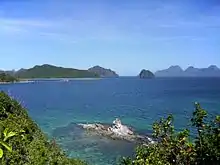
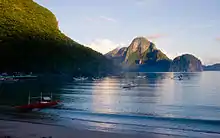
From the towering marble cliffs and lagoons to its 100[56] white sandy beaches, jungle and mangrove forest, prehistoric caves and waterfalls, El Nido is one of the top tourist destinations in Palawan, which is often referred to as the "Philippines' Last Frontier".[30] In the November–December 2007 issue of the National Geographic Traveler's magazine, Palawan was chosen as one of the best travel destinations in the world, and particularly, it recommended El Nido and the Calamianes Islands.[57] In 2012, CNNGo, the travel news website of the international news agency Cable News Network, declared El Nido as the Philippines' Best Beach and Island destination.[9]
Seven Commandos Beach
An isolated beach that is located on the mainland, but only accessible by water, due to the mountainous terrain.
Unlike most remote destinations in Bacuit Bay, there is a multi-story, high end resort here in addition to cottages and tent camping sites right on the beach. There are quite a number of small permanent structures throughout Seven Commandos. It is also a popular stop on island hopping tours.[58]
Simizu Island
A small island surrounded by clear waters of El Nido, rock formations and a scene of towering mountains. A good place as a lunch area for Island Tour A.[59][60]
Bacuit Bay
Bacuit Bay is dotted with islands and islets, most of which are inhabited. Its clear blue waters are teeming with marine life. It is home to dugongs, turtles, manta rays, species of fishes, coral reefs, and the occasional whale sharks. There are over 30 dive sites ranging in depth from six to more than thirty meters.[61]
Cadlao Island
.jpg.webp)
Cadlao is the largest island in El Nido, occupying a land area of 10.06 square kilometers. Among all islands, it is the closest to town proper and has the highest peak that towers up to 640 meters above sea level. It is known for its white sand beaches, gradually sloping sea floor, hidden lagoons, and nature trails through its forest cover. One of these nature trails leads to the saltwater Makaamo Lagoon. which is surrounded by mangroves.
There are a number of beaches on Cadlao, including that at Bocal Point, Natnat, and Paradise Beach on the southern side of the island. Sabang Beach in the north-east offers good snorkeling opportunities, though some visitors may recognize it as one of the settings for the Scandinavian TV show Robinson Expedisjonen, the predecessor to Survivor.
Dilumacad Island
Dilumacad Island has a white sand beach stretching to some 300 meters on its South Eastern side. There is an underwater tunnel at its northern side and a fringing reef on its southern end. The island is also called Helicopter Island because its limestone cliffs resemble the shape of a helicopter when it is viewed from a considerable distance. The island itself is small by land mass, but is rich in vegetation and has a thick, dense rainforest, along with some bare rock, that seems to rise directly out of the deep blue sea.[62]
Pangulasian Island
Pangulasian has 750-metre (2,460 ft) wide stretch of powdery white beaches in El Nido. The waters fronting the beach have clusters of coral reefs. A trail located in the middle of the island ends at the peak of the island and provides and a 360-degree view of the Bacuit Bay and nearby islands.
Vigan Island
Located near Pangulasian Island, Vigan is also referred to as "Snake Island," because of the natural sandspit (s-shaped sandbar) that "snakes" off it shores. The sandspit is clearly visible only when the tide is low. On both sides of the sandspit are shallow swimming areas.
Cudugnon Point
Cudugnon Point is an important anthropological site, where jewelry and pottery dating back to the Song dynasty (960-1279 CE) were yielded. The anthropologists believe that the cave dwellers were from Borneo, and travelled across the ancient land bridge that connected Palawan from Borneo. The crevices of its cave roof are inhabited by barn swallows and insectivorous bats.
Matinloc Island
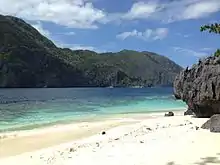
Matinloc Island, the longest slim island in El Nido, has a secret beach, which is a pocket of white sand beach at the corner of a sinkhole,[56] that is inaccessible by boat and surrounded by steep rock walls. To reach it, divers must swim underwater through a narrow crevice in a rock wall. At noon, the sun streams in through the opening, allowing a play of light and shadow against its limestone walls. The beach floor drops abruptly.[56] According to local legend, this beach inspired Alex Garland's novel The Beach, which was written while the author was in El Nido.[30]
Aside from the Secret Beach, the island is also famous for the Kulasa Beach, a 100-meter beach strip of fine white sand located at one of its coves. The sea floor surrounding the beach slopes gradually and the water deepens only after about 10 meters.[56]
There are four dive sites around the island with the one at the south tip of Matinloc being the deepest at 39 meters.[56]
Pinasil Island
Pinasil Island has a cathedral-like cavern accessible by dinghy and kayak. Its cool interior is lit at certain times of the day by sunlight coming through an opening at its peak. This one of important sites for the busyadors or the birds' nest gatherers.
Aberawan River
Aside from its several islands and beaches, tourists can also enjoy a mangrove tour along the Aberawan River where they can watch egrets roost among the mangrove trees at the mouth of the river.[63]
Ille Cave
12,000 years ago, El Nido was inhabited already by humans. Archaeologists found human and animal bones, potteries and even traces of 8,000-year-old cremation at Ille Cave. Ille is located at New Ibajay, a 45-minute drive from the town center, and is frequented by tourists.[64]
Población (El Nido town proper)
Nestled around the towering marble and limestone cliffs and green hills, the town proper is a thriving tourist center where most cottages, bars, and souvenir shops can be found.[51][65]
Maremegmeg Beach (Las Cabanas)
Just one kilometer south of Corong Corong, Maremegmeg Beach is home to one of El Nido's very first resorts. Named Las Cabanas Resort, tourists began incorrectly referring to Maremegmeg as Las Cabanas Beach, and the name stuck. There is a zip-line between the coast and a nearby island that you can access via a footpath behind the beach.[66]
Balay Tubay
A 90-year-old house turned into a bar along Calle Real where paintings and handicrafts of local artists are put on display. Every night, live music is performed there then. Originally owned by Sabas C. Robles, the grandfather of Judge Sabas Robles Acosta, father of Andrei Ustares Acosta - the Palawanologist.[67][68]
Nacpan Beach
A 4-kilometre (2.5 mi) stretch of powdery white sand and pristine azure waters which is 45 minutes to an hour away from downtown El Nido via tricycle. This rocky peninsula offers views of the twin beaches after a short vertical hike up the trail, but the land was purchased by a private developer in 2016. The developer has plans to build a luxury resort on the grounds. Protests to the sale and the building have come in the form of squatters attempting to reclaim the land. The battle between these two parties has resulted in the property being watched 24 hours by an armed security guard. Nacpan beach is formally known by the villagers as Nagpan beach, later on it was named as Nacpan beach. Nacpan is located at Sitio Calitang, EL Nido, Palawan. [69]
Duli Beach
A surfing spot of El Nido with good waves every September to March. During the summer season there are little to no waves. Nacpan has a similar wave pattern but less crowded than Duli.
Education
El Nido has more than ten public elementary and secondary schools located in most of its barangays. El Nido Central School and El Nido National High School, which are both located at the Poblacion, have the largest facilities and number of students, among these schools. Recently, the Palawan State University opened its El Nido campus in New Ibajay, offering extramural programs and studies.
References
- El Nido: What to Do in the Closest Thing to Paradise Archived 2008-08-21 at the Wayback Machine.
- Municipality of El Nido | (DILG)
- "Province: Palawan". PSGC Interactive. Quezon City, Philippines: Philippine Statistics Authority. Retrieved 12 November 2016.
- Census of Population (2015). "Region IV-B (Mimaropa)". Total Population by Province, City, Municipality and Barangay. PSA. Retrieved 20 June 2016.
- https://psa.gov.ph/sites/default/files/City%20and%20Municipal-level%20Small%20Area%20Poverty%20Estimates_%202009%2C%202012%20and%202015_0.xlsx; publication date: 10 July 2019; publisher: Philippine Statistics Authority.
- "El Nido Tourism". Archived from the original on 2011-07-10. Retrieved 2012-05-18.
- Destination: El Nido. Accessed 24, 2008.
- The Philippines' best beaches and islands Archived 2012-11-07 at the Wayback Machine. CNN Go website. Accessed May 15, 2012.
- El Nido named Best Philippine Beach. ABS-CBN website. Accessed May 15, 2012.
- Destination of the Month: El Nido, Palawan Archived 2017-08-04 at the Wayback Machine. Wow Philippines UK website. Accessed May 15, 2012.
- Official Website of the Province of Palawan. Accessed August 28, 2008. Archived August 27, 2008, at the Wayback Machine
- Palawan Council for Sustainable Development: Protected Areas. Accessed September 05, 2008.
- On Shaky Ground Archived 2009-12-18 at the Wayback Machine.
- North Palawan Block, Philippines--Its Relation to Asian Mainland and Role in Evolution of South China Sea. Accessed March 29, 2010.
- "El Nido, Philippines: Average Temperatures and Rainfall". World Weather Online. Retrieved 15 September 2014.
- Philippine Country. Accessed August 25, 2008.
- History of Palawan Archived 2009-01-15 at the Wayback Machine. Campersponit website. Accessed January 26, 2009.
- "Republic Act no. 1140". Chan Robles Virtual Law Library. Retrieved on 2010-10-20.
- "An Act Creating Certain Barrios in the Municipality of El Nido, Province of Palawan". LawPH.com. Archived from the original on 2012-07-11. Retrieved 2011-04-12.
- "An Act Changing the Name of Barrio Oton, Municipality of El Nido, Province of Palawan, to Mabini". LawPH.com. Archived from the original on 2012-07-13. Retrieved 2011-04-13.
- Salaverria, Leila B. "Plebiscite on splitting Palawan into 3 provinces set for 2020". Philippine Daily Inquirer. Retrieved 2019-04-16.
- "Paghahati ng Palawan sa 3 probinsiya batas na | Pilipino Star Ngayon". The Philippine Star. Retrieved 2019-04-16.
- "Duterte signs law breaking up Palawan into 3 provinces". Rappler. Retrieved 2019-04-16.
- https://news.abs-cbn.com/news/04/15/19/dividing-palawan-residents-look-to-challenge-palawan-split-into-3-provinces
- https://www.scmp.com/week-asia/article/2186449/explained-south-china-sea-dispute
- Census of Population and Housing (2010). "Region IV-B (Mimaropa)". Total Population by Province, City, Municipality and Barangay. NSO. Retrieved 29 June 2016.
- Censuses of Population (1903–2007). "Region IV-B (Mimaropa)". Table 1. Population Enumerated in Various Censuses by Province/Highly Urbanized City: 1903 to 2007. NSO.
- "Province of Palawan". Municipality Population Data. Local Water Utilities Administration Research Division. Retrieved 17 December 2016.
- El Nido: Info. Accessed August 24, 2008.
- 2000 Census of Population and Housing:Palawan. Accessed August 27, 2008. Archived August 23, 2008, at the Wayback Machine
- Population Census 2007 Press Release. Accessed August 27, 2008 Archived August 25, 2008, at the Wayback Machine
- "Municipality of El Nido". Philippine National Statistical Coordination Board. Retrieved on 2010-10-20.
- "Poverty incidence (PI):". Philippine Statistics Authority. Retrieved 28 December 2020.
- https://psa.gov.ph/sites/default/files/NSCB_LocalPovertyPhilippines_0.pdf; publication date: 29 November 2005; publisher: Philippine Statistics Authority.
- https://psa.gov.ph/sites/default/files/2003%20SAE%20of%20poverty%20%28Full%20Report%29_1.pdf; publication date: 23 March 2009; publisher: Philippine Statistics Authority.
- https://psa.gov.ph/sites/default/files/2006%20and%202009%20City%20and%20Municipal%20Level%20Poverty%20Estimates_0_1.pdf; publication date: 3 August 2012; publisher: Philippine Statistics Authority.
- https://psa.gov.ph/sites/default/files/2012%20Municipal%20and%20City%20Level%20Poverty%20Estima7tes%20Publication%20%281%29.pdf; publication date: 31 May 2016; publisher: Philippine Statistics Authority.
- https://psa.gov.ph/sites/default/files/City%20and%20Municipal-level%20Small%20Area%20Poverty%20Estimates_%202009%2C%202012%20and%202015_0.xlsx; publication date: 10 July 2019; publisher: Philippine Statistics Authority.
- Guardians of the bird nests. Accessed September 05, 2008.
- http://perispalawantraveljournal.blogspot.com. Accessed August 26, 2008.
- Oil exploration firm sells stake in Cadlao oilfield Accessed September 05, 2008.
- UNESCO:El Nido-Taytay Managed Resource Area. August 26, 2008.
- Palawan Tourism Council Archived 2008-05-16 at the Wayback Machine
- El Nido Tourism Protected Area Archived 2011-10-04 at the Wayback Machine. Accessed March 29, 2010.
- Palawan Council for Sustainable Development: El Nido - Taytay Managed Resource Protected Area. Accessed 26, 2008
- El Nido as a Protected Area. Accessed August 24, 2008.
- The ceramic corals of El Nido. Accessed September 10, 2008. Archived May 14, 2006, at the Wayback Machine
- El Nido: Transportation
- Official Website of the Province of Palawan: Infrastructure. Accessed September 10, 2008. Archived August 27, 2008, at the Wayback Machine
- El Nido FAQs. El Nido Boutique and Art Cafe. Accessed November 27, 2009.
- http://www.unofficialguide.ph/where-to-stay-in-el-nido/
- Official Website of the Province of Palawan: Public utilities. Accessed August 28, 2008. Archived August 27, 2008, at the Wayback Machine
- El Nido FAQs Archived 2009-03-10 at the Wayback Machine. Accessed March 29, 2010.
- Palawan website. Accessed September 10, 2008. Archived September 15, 2008, at the Wayback Machine
- Top 10 El Nido's finest beaches Archived 2009-02-08 at the Wayback Machine. Accessed September 14, 2008.
- Palawan listed among the world's best tourist sites. Accessed September 05, 2008.
- http://www.unofficialguide.ph/seven-commando/
- El Nido: Tour A. Let's Wander Around El Nido, Palawan
- http://www.unofficialguide.ph/island-hopping-essentials-in-el-nido/
- El Nido: Scuba. Accessed August 24, 2008.
- http://www.unofficialguide.ph/helicopter-island/
- El Nido - an eco-friendly paradise. Accessed November 11, 2015.
- Uni-tuebingen Homepage Archived 2007-07-03 at the Wayback Machine. Accessed January 22, 2009.
- Plaza, Mary Anne. A long walk in El Nido town. Palawan.com. Accessed November 27, 2009. Archived January 4, 2011, at the Wayback Machine
- http://www.unofficialguide.ph/marimegmeg/
- El Nido Nightlife. Virtual Tourist. Accessed November 27, 2009.
- Balay Tubay Archived 2010-11-02 at the Wayback Machine. Gecko Go. Accessed November 27, 2009.
- http://www.unofficialguide.ph/twin-beach-hike/
External links
| Wikivoyage has a travel guide for El Nido. |
| Wikimedia Commons has media related to El Nido, Palawan. |